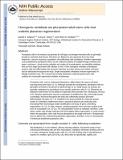| dc.contributor.author | Wagner, D. E. | |
| dc.contributor.author | Wang, Irving E. | |
| dc.contributor.author | Reddien, Peter | |
| dc.date.accessioned | 2017-07-07T18:52:14Z | |
| dc.date.available | 2017-07-07T18:52:14Z | |
| dc.date.issued | 2011-05 | |
| dc.date.submitted | 2011-02 | |
| dc.identifier.issn | 0036-8075 | |
| dc.identifier.issn | 1095-9203 | |
| dc.identifier.uri | http://hdl.handle.net/1721.1/110557 | |
| dc.description.abstract | Pluripotent cells in the embryo can generate all cell types, but lineage-restricted cells are generally thought to replenish adult tissues. Planarians are flatworms and regenerate from tiny body fragments, a process requiring a population of proliferating cells (neoblasts). Whether regeneration is accomplished by pluripotent cells or by the collective activity of multiple lineage-restricted cell types is unknown. We used ionizing radiation and single-cell transplantation to identify neoblasts that can form large descendant-cell colonies in vivo. These clonogenic neoblasts (cNeoblasts) produce cells that differentiate into neuronal, intestinal, and other known postmitotic cell types and are distributed throughout the body. Single transplanted cNeoblasts restored regeneration in lethally irradiated hosts. We conclude that broadly distributed, adult pluripotent stem cells underlie the remarkable regenerative abilities of planarians. | en_US |
| dc.description.sponsorship | National Institutes of Health (U.S.) (R01GM080639) | en_US |
| dc.language.iso | en_US | |
| dc.publisher | American Association for the Advancement of Science (AAAS) | en_US |
| dc.relation.isversionof | http://dx.doi.org/10.1126/science.1203983 | en_US |
| dc.rights | Creative Commons Attribution-Noncommercial-Share Alike | en_US |
| dc.rights.uri | http://creativecommons.org/licenses/by-nc-sa/4.0/ | en_US |
| dc.source | PMC | en_US |
| dc.title | Clonogenic Neoblasts Are Pluripotent Adult Stem Cells That Underlie Planarian Regeneration | en_US |
| dc.type | Article | en_US |
| dc.identifier.citation | Wagner, D. E.; Wang, I. E. and Reddien, P. W. “Clonogenic Neoblasts Are Pluripotent Adult Stem Cells That Underlie Planarian Regeneration.” Science 332, 6031 (May 2011): 811–816 © 2011 American Association for the Advancement of Science (AAAS) | en_US |
| dc.contributor.department | Massachusetts Institute of Technology. Department of Biology | en_US |
| dc.contributor.mitauthor | Wang, Irving E. | |
| dc.contributor.mitauthor | Reddien, Peter | |
| dc.relation.journal | Science | en_US |
| dc.eprint.version | Author's final manuscript | en_US |
| dc.type.uri | http://purl.org/eprint/type/JournalArticle | en_US |
| eprint.status | http://purl.org/eprint/status/PeerReviewed | en_US |
| dspace.orderedauthors | Wagner, D. E.; Wang, I. E.; Reddien, P. W. | en_US |
| dspace.embargo.terms | N | en_US |
| dc.identifier.orcid | https://orcid.org/0000-0002-5569-333X | |
| mit.license | OPEN_ACCESS_POLICY | en_US |
